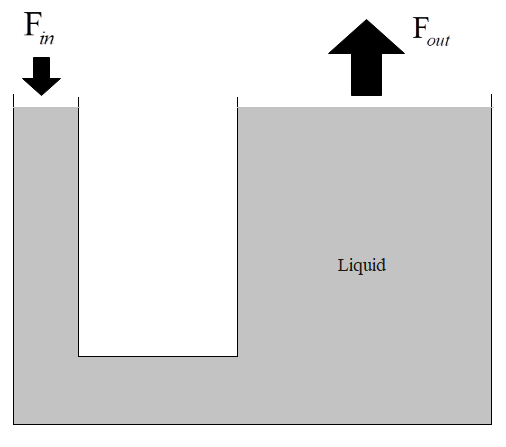Question
Question: In a hydraulic lift, the small piston has an area of \(2\text{ c}{{\text{m}}^{2}}\) and the large pi...
In a hydraulic lift, the small piston has an area of 2 cm2 and the large piston has an area of 80 cm2. What is the mechanical advantage of the hydraulic lift?
A. 40
B. 42
C. 10
D. 04

Solution
Mechanical advantage is the ratio of force produced by any machine to the force applied on it. Use Pascal’s principle to calculate mechanical advantage of the hydraulic lift.
According to Pascal’s law, “when a static pressure is applied on an incompressible liquid, it is distributed or transmitted equally throughout the liquid in all directions.”
Complete step-by-step answer:
A hydraulic lift is a system consisting of two pistons of different sizes which are connected by a reservoir filled with hydraulic liquid. When a smaller input force is applied on a smaller piston, it results in greater force on a large piston. So there is a mechanical advantage. This property makes it possible to lift heavy motor-cars by applying lesser force.
To calculate the mechanical advantage of the hydraulic lift we use Pascal’s principle. According to Pascal, liquids cannot be compressed and they distribute the pressure equally.
Therefore pressure at smaller piston equals the pressure at large piston and we know that pressure is calculated as force per unit area. Therefore
AsFin=ALFout
Where
Fin=Force applied on smaller piston
Fout=Resulting force on large piston
A1=Area of small piston
A2=Area of large piston
We note from the question that A1=2 cm2and A2=80 cm2. On substituting these values in Pascal’s relation we get
2Fin=80Fout
Now we rearrange the expression and obtain mechanical advantage
FoutFin=280⇒ Mechanical advantage = 40
So, the correct answer is “Option A”.
Additional Information: Mechanical advantage is unitless quantity as it is the ratio of input and output forces.
Several other devices like hydraulic brakes, hydraulic pressure jacks are based on the same principle.
Note: Any force applied to a liquid is transmitted uniformly in all directions throughout the liquid. One of its consequences is Pascal’s ball. Pascal’s ball is a rubber ball with multiple holes in it. When water is filled and pressure is applied water flows out from all its holes with the same speed.
